skip to main |
skip to sidebar

© 2009 Simon Hucko
We've all been there - you see a moment you want to capture, grab your camera, jam your finger down on the shutter button, and then wait an eternity for the picture to actually be taken. By that time you've missed the decisive moment (wikipedia), and are left cursing your camera. This is especially common with digital point n shoots, which are notoriously slow to focus, but even fancy DSLR's have some amount of focus and shutter lag.
How do you overcome this? Learn to anticipate and pre-focus.
Anticipating a great photograph is not always easy (or possible), but there are plenty of circumstances where you know what's coming. The kiss at a wedding. Your 5 year old niece blowing out candles on her birthday cake. A batter swinging at a pitch. By knowing what's coming, you can have your camera out and ready to go.
That brings us to the next step: pre-focus. Focus on your subject by half-pressing the shutter and make sure you frame the shot how you want it (keeping in mind that there may be some subject movement or additional elements added before the decisive moment).
Now when the moment happens you'll be all set to capture it, and don't have to wait for the camera to figure everything out. All cameras will still have some small amount of shutter lag, so you will still have to compensate by shooting a little bit earlier than the moment you want to capture. This requires some timing and practice, but the nice thing is that it's consistent so once you've got it down you'll be able to get it right just about every time.
~S
[title of blog] on flickr
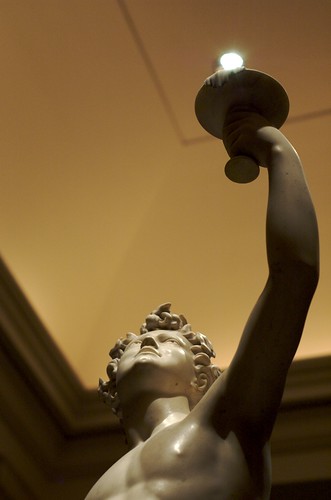
© 2009 Simon Hucko
One of the unique (and sometimes frustrating) things about photography is that it forces the viewer to adopt a static perspective on a scene. Since photographs are two-dimensional, you can use this to your advantage when looking for creative photographs. I'm sure you've all seen photos where people in the foreground seem to be interacting with the background - holding up the leaning tower of Pisa, for instance. This technique is known as "forced perspective."
Aside from creating comic mementos of your vacation, forcing perspective can add interesting elements to your photographs. Take today's photo. I saw the sculpture, and noticed the recessed ceiling lights above it. Immediately I thought of trying to "light" his torch, and started squatting down and finding a perspective that would allow me to get that shot. I'm sure I looked pretty silly doing it, but you can't argue with the results. As an added bonus, the perspective matches the statue (looking up at the torch), so it lends itself well to this subject.
Remember that perspective is a very powerful part of composition. Try viewing your subject from several different angles (low, high, straight on, from an angle, sideways, from behind) and see which offers the most interesting image. That makes an interesting exercise, as well - take a picture of a subject from every angle you can imagine and compare them all afterward. How does your perception of a subject change based on perspective?
~S
[title of blog] on flickr
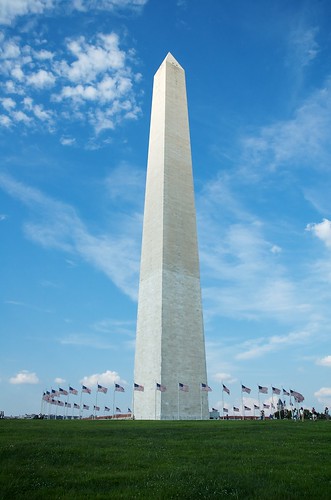
© 2009 Simon Hucko
Basic "rules" of composition stipulate that you should not place your subject at the center of the frame. The oft-touted rule of thirds (wikipedia.org) is commonly used by photographers to frame/crop their images, and a lot of cameras even include an optional rule of thirds guide in the viewfinder/preview window. Generally the idea is to keep the main subject out of the center of the frame, which results in a more natural, dynamic image.
However, there are times when a centered composition can be used very effectively. This is especially true when the subject displays a lot of symmetry, showcased by today's photo of the Washington Monument. The monument, the ring of flags, and the expanse of grass in front all create a very centered and symmetrical feeling. The wisps of clouds in the sky help add a little interest and drama, but the photo would have been fine without them.
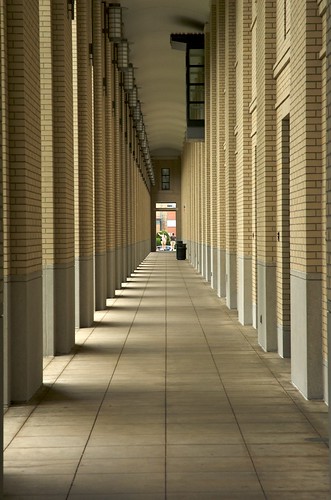
© 2009 Simon Hucko
Another example showing a lot of symmetry and a centered "subject." Note that this technique works very well with architecture, since most buildings are designed to be symmetrical, but you can use it with other subjects as well.
Thoughts? Feelings? Comments? Questions? Critiques? Stories? Other symmetry pictures? Please share!
~S
[title of blog] on flickr

© 2009 Simon Hucko
Quick tip today - always look for a detail shot, something that helps tell the story of the event you're shooting. This is especially great if you're planning on doing some sort of book or other multiple photo layout from the event.
Take today's photo - the connection between bride and groom. Not something you'd get a large framed print of, but it was a great addition to the photo book my wife made of the wedding.
Here's another example from when I was taking photos before a school play:

© 2009 Simon Hucko
Again, not something you would probably print on its own, but it was a nice addition to the set of people getting ready and added to the overall story.
Keep an eye out for the detail shots. You'll be glad you did
~S
[title of blog] on flickr
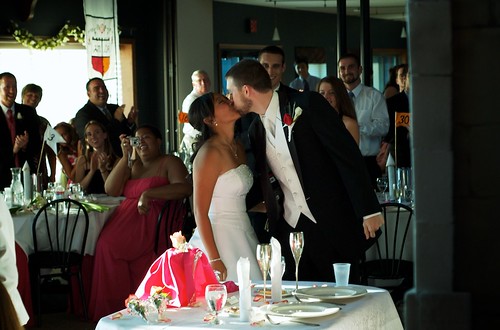
© 2009 Simon Hucko - view it large here
Internet photo-sharing sites have made people's photography incredibly accessible. You upload a photo, and anyone in the world with an internet connection has the chance to view and comment on it. While this is great for getting exposure and sharing photos with friends and family, it does come with a few downsides.
One of the biggest downsides (in my mind) is that the sites force your photos into small sizes. The normal view for a photo on flickr is 500p on the long edge (which is the same size I use here on the blog). And that's if someone has clicked through to your photo page. In other parts of the site your photos are relegated to even smaller sizes, and at times arbitrarily cropped into a tiny square thumbnail. The problem? Not all photos read well that small.
Take today's photo. Even at 500p, the background looks cluttered and busy. I had someone suggest that I add some blur to the background to help take away the distraction from the couple. I don't disagree with that, and a shallower depth of field or some photoshop would help isolate the main subject.
But, do me a favor and view that photo larger. Take a minute to look at the background, and everything that's going on there. What looks like a random bunch of heads at 500p suddenly becomes a wealth of expression and celebration of the couple's kiss. It's even better at the original image size, which I don't have posted. All of the action in the background adds to the story of the photo, and gives it more depth than just a nice picture of a bride and groom kissing.
The moral of this story is, find a way to view your photos larger. Find sites that will let you display your work at a larger resolution. Alert people to the fact that your image will probably look better larger and ask them to click through. Also, larger format prints are an awesome (albeit slightly expensive) way to look at your work, and I highly recommend taking a few of your hero shots and getting them printed up at 8x10 or larger. There is something truly satisfying about holding a print of your work in your hands and taking in every detail.
__________________________________
NOTE: I'm not trying to call out the person who made that comment, or say that they were wrong. You can definitely make the point that the background is too busy. It's all subjective, and there is no right or wrong. I love getting comments and criticism (yes, criticism) on my work, and being able to discuss it with people beyond "great shot!" "thanks." So thank you for the inspiration.
Feel free to write your thoughts/feelings on it as a comment here or on the flickr page
~S
[title of blog] on flickr

© 2009 Simon Hucko - view large on black here
Shooting through a crowd of people is hard, and usually doesn't produce very good results. I find I do a lot of cropping in situations like that, and the subject is typically framed by the back of two heads which can be distracting.
The solution? Start shooting without looking through the viewfinder. If you're using a point n shoot or one of the fancy new DSLRs, you've got it made - just make sure the preview is on and raise your camera up. Those of us without live preview have it a little harder - you have to shoot blind and hope you get something usable.
I've been working on this technique lately for a few reasons. The main one is to get above a crowd of people and get a shot of what I want. Today's picture is a perfect example. Everyone was sitting at the ceremony (including me) and I reached up and fired off a few frames. The resulting image looks like I was standing in the middle of the crowd, but this way I didn't make anyone mad (I hope). The key to this is to shoot pretty wide so you can straighten/crop later. A fast shutter speed helps too, since you won't be able to support your camera as well with one arm straight up in the air.
Another reason to work on no-look shooting is to avoid the "camera reaction" from people. Candids are very hard to get, and there are really only two ways to capture a candid moment. The way I usually do it is to have my camera out and up to my face long enough that people stop caring and go about what they were doing. But if you want to grab a quick moment that may not return, you're going to have to shoot people without them knowing. Aiming from your chest and firing off a few shots can return great results. I recommend sharing your pictures with the people afterward, but that's a moral issue and I won't go into that here.
You can also use this technique to get a unique perspective on your photos. Yesterday's post is an example of this - I held the camera low to get a shot from the dog's level. Sure, I could have sprawled out on the dock, but it's faster and easier to be able to do it without looking.
A little practice with no-look shooting can pay dividends down the line. Give it a try next time you're out shooting - it's a great way to add new a perspective to your images.
~S
[title of blog] on flickr

© 2009 Simon Hucko
Today's photo breaks a few photography "rules" - the horizon is crooked, I chopped off half of the person, the subjects of the photo are way underexposed, and the white balance is very cool (blue) compared to what it should be. Personally, I love it. It was an interesting combination of artistic intent and chance.
I was shooting mid-morning into the sun at the end of a dock, so I knew the subjects would be back-lit. I even took it a little farther by bumping up the black point in post. I wanted blue sky and silhouettes - sometimes detail on the subjects can be distracting and take away from the story of the photo (in this case, the interaction between dog and owner). I also cooled down the white balance a little to bring out the blue in the lake and sky. All of this I had more or less decided on before hand.
The crazy tilt and framing was basically an accident. Mea (the dog) came running by and I held my camera low and wide and fired away. I thought about straightening it up in post, but a. it would have cropped part of the dog and even more of the person and b. I liked the dynamic feel imparted by the lines leading up and right into the frame (which was the same way Mea was running).
It was an interesting weekend of photography - I did a lot of no-look shooting (something I've been working on), shot with the pop-up flash on my camera (horror of horrors, but I had no choice), played with different crop ratios when editing, grabbed a bunch of shots for a pano that I still have to stitch together, and even took some video with my point n shoot which I'm going to play around with editing this week (more to come on that later).
How was your weekend? Any interesting stories or photos? Feel free to share here or in our flickr group
~S
[title of blog] on flickr

© 2009 Simon Hucko - click to view larger
"The best camera is the one you have with you." Not sure who said that originally, but it's certainly one of the truisms of photography. When the plane landed in the Hudson river back in January, the iconic image that spread all over the internet and news media was captured with an iPhone by a passenger on one of the ferries. The quality isn't great, and it was shot through a dirty window, but it told the story perfectly from a unique perspective. There were thousands of other images from that event, but this one was the first and most personal to make it out.
My story is completely lame by comparison, but it reminded me of why I always make sure I have a camera with me. I was driving home last night through the valley and there was a weird inversion thing going on causing some misty clouds to be hanging onto the hilltops despite the blue sky above. In the year that I've been making this commute I've never seen anything like it. I found a suitable vantage point, grabbed my camera, and fired off a few frames. My favorite is posted above (click on the photo to see it larger). It's not newsworthy, and it may not even be a great photo, but it captured a unique event and I'm glad I had a camera with me. In fact, my camera bag usually goes most places with me (much to my wife's dismay). If I don't want to bring "the big camera" I might still grab my point n shoot and slip it into a pocket. If nothing else, I always have my camera phone with me.
Not only do I take pictures of interesting things that happen, but I use my cameras like a notepad, taking pictures of things I'll want to remember later - my parking space, a good bottle of wine, gift ideas, books, documents, notes on a whiteboard, restaurants I want to try, etc.
What about you - do you carry a camera with you? Do you use it for anything aside from taking pretty pictures? Have you ever wished you had one when you didn't? Comment and let me know your thoughts
~S
[title of blog] on flickr

© 2009 Simon Hucko
If you've spent any time on photography forums on the internet you're bound to have come across the word "bokeh" and all of the controversy surrounding it. Bokeh (don't ask me to pronounce it correctly, I have no idea) is a word created by Japanese photographers to describe the quality of the out of focus portions of an image. I came across a great article online the other day defining bokeh and giving examples of the different factors that go into the judgement of a lens' bokeh. Check it out:
Bokeh (toothwalker.org)
Hope that helps.
~S
[title of blog] on flickr
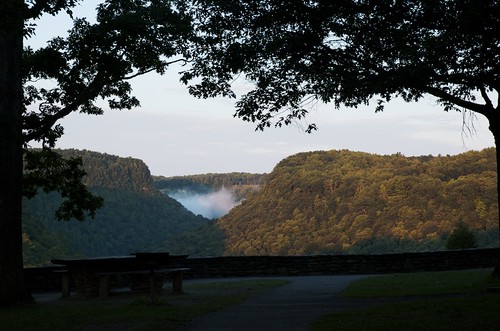
© 2009 Simon Hucko
Well, I did it. Woke up before 6am on Saturday and ventured out to take some photos with my dad. I was hoping to capture the waterfalls there at sunrise, but apparently the light doesn't make its way down into the gorge until much later in the morning. While we were on our way to the falls, I saw the vista above and pulled the car right over. Great golden light, the mist rising in the valley, I couldn't pass it up. I think I even said "ooooo" as I hit the breaks. Later that morning I headed back out to go to the waterfalls and walk around/shoot a little. On my way, I stopped at the same place and took the following picture:

Oops! Thanks for the heads up about the busted photo. Should be fixed now
Not exactly the same framing, and not as extensively edited, but I think it gets the point across pretty well. The rich golden light is gone. The mist has evaporated. The sky is blown out. The foreground trees are no longer in silhouette. What was a unique landscape photograph became a run of the mill snapshot that every single visitor to the park has taken. The difference? 4 hours. The first photo was taken at 6:23am (sunrise was at 6:11am that day). The second was taken at 10:28am.
The lesson? If you want unique pictures, you're going to have to work for it. Timing is everything, and knowing when your subject will look its best can make or break a photograph. Do some research and scout out photo opportunities before hand so you know how to get the best shot possible.
~S
[title of blog] on flickr
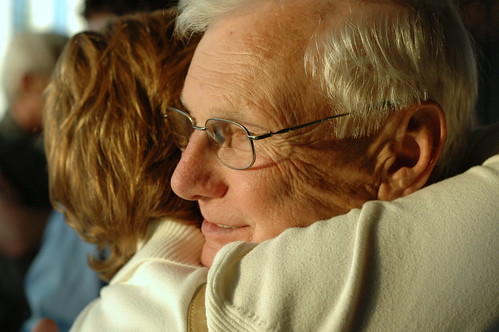
© 2009 Simon Hucko
Want to take your photography to the next level? Start shooting during "the golden hour" - the hour after sunrise or before sunset when the sun is still very low in the sky. The low position of the sun does several things. First, it changes the angle of light from overhead to being more direct, eliminating problematic shadows (raccoon eyes, for example). It also provides a lot of textural definition to a scene, especially when you shoot with the sun coming in 90* from where you are, and can help make a landscape more dynamic and interesting.
The most notable effect (and the namesake for "the golden hour") is the dramatic change in the quality of light. Since the light passes through more of the atmosphere to reach you, it becomes more diffuse. It also becomes less blue, giving things a pleasing warm (or golden) tone.
Finally, the diffuse light isn't as bright, which compresses the tonal range of a scene and helps prevent blown highlights and muddy shadows in your images.
Golden hour light is generally preferred for photographing landscapes, as it reduces the dynamic range and provides some nice illumination on the scene. This is the main reason why a professional image of a landscape/waterfall/vista/city skyline/etc looks so much better than your photo taken at high noon. It also is great light for people/portrait photography, and you can take some amazing natural light portraits armed with only your camera and some type of reflector or fill card.
I'm going camping this weekend at Letchworth Park (Mount Morris, NY), which is home to several waterfalls and a giant dam. Unfortunately for me, all of them face east, so I'm going to try to wake up before dawn so I can capture them in that early golden hour light. I'll report back next week on whether or not I actually get up that early...
~S
[title of blog] on flickr

© 2009 Simon Hucko
With the progression of photo editing software, it has never been easier to add some creative processing to your images. Black and white, sepia toning, cross-processing, de-saturation, over-saturation, selective color, vignetting, color balance shifts - the list goes on and on. When used correctly, these techniques can bring a whole new feeling to an image.
The image above was taken in Times Square on Sunday. The color shot had some neon on the left that distracted from the main subject. By converting to black and white, I eliminated that distraction and put the focus back onto the man with the bicycle. It also makes the image feel older, creating the feeling (to me at least) that it's the city that's out of place, not the man with the bike. That bit of creative processing turned a good shot into a great one.
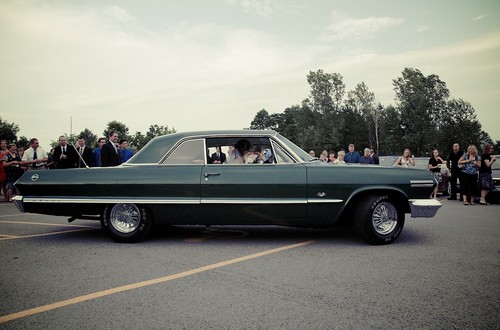
© 2009 Simon Hucko
This shot benefited from some cross-processing. Cross-processing is a technique that used to be applied to film and gave it that washed out warm look that many of us associate with old color photographs (more to come on this, I promise). I wanted to create that feeling with this image to compliment the awesome vintage car they were leaving in. Here's the same image without the cross-processing applied:
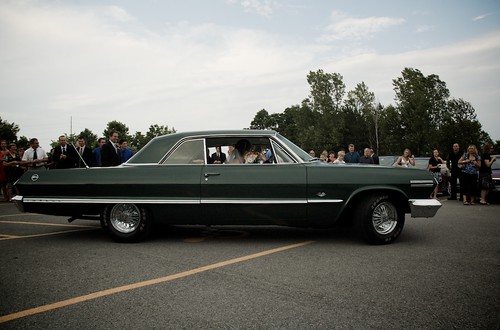
Nice, but to me it doesn't have the same visual and emotional impact as the processed image.
It's easy to get caught up in digital processing and apply crazy creative effects to every photo you take. The key to making an impact with your processing is to have some motivation behind it. Why are you choosing to process your image that way? What effect does it have, both visually and emotionally? How does it help tell the story you want? Just like focal length, framing, composition, lighting and timing, processing is another important step in the creative process. Don't throw away the work you put into making a good photograph by applying unnecessary effects in post.
________________________________
[[Warning - shameless self promotion]]
I really like today's first image (view it larger here), and am considering making a print edition available. Is there any interest for that? Haven't figured out the specifics yet, but it would be a larger format limited edition signed print, possibly matted. Thoughts?
~S
[title of blog] on flickr

© 2009 Simon Hucko
My wife and I took her cousin to NYC on Sunday to see a show and do some shopping/walking around. I brought my camera, both to document the day and to try my hand at some street photography.
Unfortunately, we were greeted by rain, leading up to a pretty big storm around lunch time. I could have given up and put my camera away, but I kept it out and kept shooting. I had an umbrella with me (a must have accessory for every photographer), so I carried my camera close to my chest and did a lot of one handed shooting.
Shooting in the rain is a very easy way to up the interest factor for your images. For one thing, every picture automatically has a story to tell ("it was raining and..."). For another, people generally don't hang out in the rain and observe what's going on, so your photos will provide a unique look at the world. Rain also lends itself to reflections, which can turn an ordinary street scene into a whirl of color and light. The photo above was taken in Times Square during the height of the storm. The wet pavement reflected all of the lights, adding a lot of color and interest to the scene.
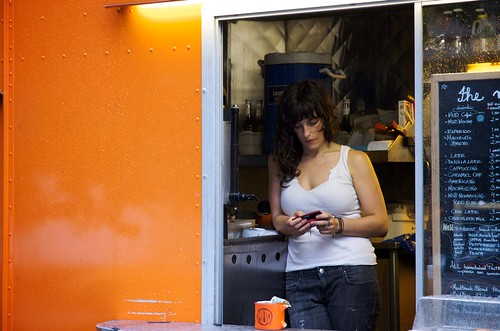
© 2009 Simon Hucko
An example in the "it was raining and..." category: it was raining and this woman was waiting for things to clear up and her customers to return.
Bad weather is a drag, especially if you're travelling and can't just come back when the weather is how you like it. However, if you make the most of it, bad weather can lead to some very interesting and unique photographs.
Photo set from the day here
~S
[title of blog] on flickr
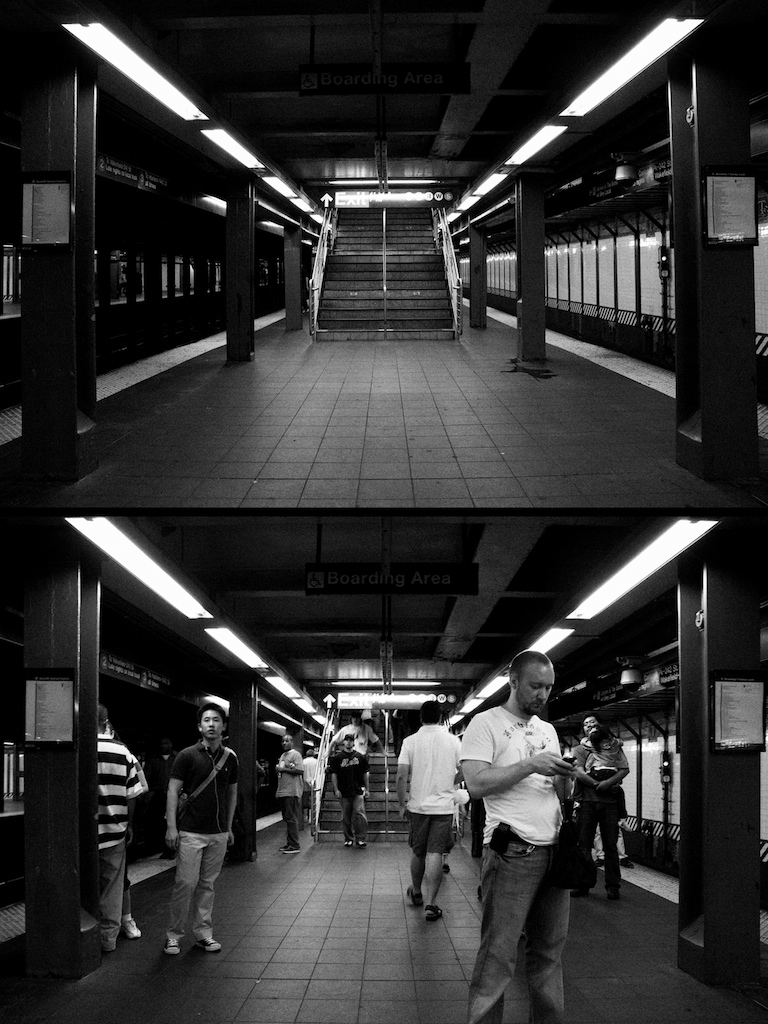
© 2009 Simon Hucko
Looking for a creative way to tell a story with your photography? Cheat with multiple photos in one! Diptychs (two photos) or triptychs (three photos) can act like short stories, conveying some meaning in multiple images that isn't present in an individual photo. My photo above plays with time, showing an empty subway platform become filled with people waiting for a train. There are many other ways to take advantage of displaying multiple photos together.
Diptychs/Triptychs can be a good way to get yourself to think about story telling through photography. Next time you're shooting, keep an eye out for opportunities to create one, and share it in the [tob] flickr group.
~S
[title of blog] on flickr

![[title of blog]](http://1.bp.blogspot.com/_dADuhpc-QVg/TJkTQCq15KI/AAAAAAAAKtQ/usbfWPD7pjc/S1600-R/waterfall.png)





















